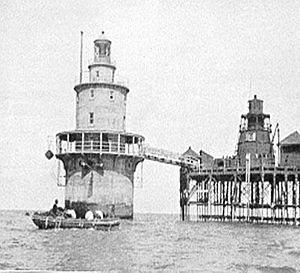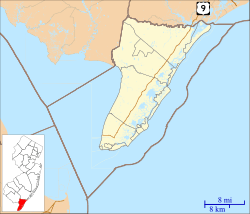Brandywine Shoal Light facts for kids
 |
|
| Brandywine Shoals Light (undated USCG photo) | |
|
|
|
| Location | lower Delaware Bay |
|---|---|
| Coordinates | 38°59′11″N 75°06′49″W / 38.9864°N 75.1135°W |
| Year first constructed | 1828 (1st light) 1850 (2nd light) 1914 (3rd light) |
| Automated | 1974 |
| Foundation | wood piles (1st light) screw-pile (2nd light) cast iron/concrete caisson (3rd light) |
| Construction | cast iron (2nd light) reinforced concrete (3rd light) |
| Tower shape | conical/cylindrical house with lantern on top (2nd and 3rd lights) |
| Focal height | |
| Original lens | third order Fresnel lens |
| Range | 13 nautical miles (24 km; 15 mi) |
| Characteristic | 10s flash |
The Brandywine Shoal Light is a famous lighthouse located in Delaware Bay, on the east coast of the United States. It sits west of Cape May, New Jersey. This lighthouse is special because it was the very first screw-pile lighthouse ever built in the United States!
Contents
History of the Brandywine Shoal Light
Early Attempts to Build a Light
Before a lighthouse could be built, a special ship called a lightship was used. This ship, named "N", was placed near the Brandywine Shoal in 1823. It stayed there for many years, even though it was in poor condition.
In 1827, people tried to build a permanent light on the shoal. They used wooden piles, but the strong ocean waves destroyed it in less than a year. Later, in 1835, there was a plan for a light on a stone pier. However, this idea was too expensive and was canceled.
The First Screw-Pile Lighthouse (1850)
Engineers in America learned about a new building method from the Maplin Sands Lighthouse in England. This method used "screw-piles," which are like giant screws drilled into the seabed. This made building foundations in soft ground much easier and cheaper.
Major Hartman Bache and Lt. George Meade decided to try this new screw-pile method. They built a cone-shaped iron structure that rested on nine piles. This new lighthouse was first lit in 1850.
However, it soon became clear that the lighthouse wasn't strong enough to resist moving ice. So, over the next eight years, 68 more piles were added around the light. A wooden platform was built on top of these piles, and the lighthouse stood in the center.
A Brighter Light: The Fresnel Lens
In 1851, the Brandywine Shoal Light received a new, advanced Fresnel lens. This was only the third lighthouse in America to get one! The new lens was much brighter than the old reflector systems used in other lighthouses.
The Lighthouse Board, a group that managed lighthouses, tested the new lens. They compared the Brandywine Shoal Light to the Cape Henlopen and Cape May lighthouses. Even though Brandywine Shoal was farther away, its light was much brighter. This test showed how good the Fresnel lens was. Because of this, the Lighthouse Board decided to install Fresnel lenses in all lighthouses starting in 1852.
The Modern Lighthouse (1914)
The screw-pile lighthouse worked for many years, but its small size and rusting piles became a concern. So, the Lighthouse Board decided to build a new, stronger lighthouse. This new light was finished in 1914.
The new lighthouse was built on a strong base made of cast iron and concrete. It had a reinforced concrete tower. The old screw-pile lighthouse structure was removed, but its wooden platform stayed until the 1950s. The Navy used it for different purposes. A small artificial harbor was also built around it using rocks, and it's still there today.
The original Fresnel lens from the old lighthouse was moved to the new one. Later, it was moved again to the Tuckerton Seaport museum, where you can see it today! The Brandywine Shoal Light became automated in 1974, meaning it no longer needed people to operate it. At that time, it was the last lighthouse in Delaware Bay that still had a crew.
Today, the Brandywine Shoal Light is still an active aid to navigation, helping ships find their way. It is also listed on the National Register of Historic Places, which means it's an important historical site. In 2011, the government offered the Brandywine Shoal Light and other lighthouses to public groups who would help preserve them.


